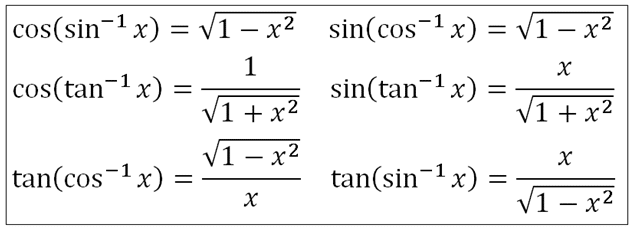The inverse trigonometric identities or functions are additionally known as arcus functions or identities. Fundamentally, they are the trig reciprocal identities of following trigonometric functions
- Sin
- Cos
- Tan
These trig identities are utilized in circumstances when the area of the domain area should be limited.
These trigonometry functions have extraordinary noteworthiness in
- Engineering.
- Air & Road Navigations.
- Physics.
- Geometry.
- Many others
Here we have offered you with the table appearing Inverse trigonometric identities or functions of all the basic trigonometric identities

Properties of Inverse Trig Identities
Property 1
- sin-1 (1/x) = cosec-1x , x ≥ 1 or x ≤ -1
- cos-1 (1/x) = sec-1x , x ≥ 1 or x ≤ -1
- tan-1 (1/x) = cot-1x , x > 0
Proof : sin-1 (1/x) = cosec-1x , x ≥ 1 or x ≤ -1,
Let sin−1x=y
i.e. x = cosec y
1x=siny
sin−11x)=y
sin−11x)=cosec−1x
sin−1(1x)=cosec−1x
Hence, sin−11x=cosec−1x where, x ≥ 1 or x ≤ -1.
Property 2
- sin-1(-x) = – sin-1(x), x ∈ [-1,1]
- tan-1(-x) = -tan-1(x), x ∈ R
- cosec-1(-x) = -cosec-1(x), |x| ≥ 1
Proof: sin-1(-x) = -sin-1(x), x ∈ [-1,1]
Let, sin−1(−x)=y
Then −x=siny
x=−siny
x=sin(−y)
sin−1=sin−1(sin(−y))
sin−1x=y
sin−1x=−sin−1(−x)
Hence,sin−1(−x)=−sin−1 x ∈ [-1,1]
Property 3
- cos-1(-x) = π – cos-1 x, x ∈ [-1,1]
- sec-1(-x) = π – sec-1x, |x| ≥ 1
- cot-1(-x) = π – cot-1x, x ∈ R
Proof : cos-1(-x) = π – cos-1 x, x ∈ [-1,1]
Let cos−1(−x)=y
cosy=−x x=−cosy
x=cos(π−y)
Since, cosπ−q=−cosq
cos−1x=π−y
cos−1x=π–cos−1–x
Hence, cos−1−x=π–cos−1x
Property 4
- sin-1x + cos-1x = π/2, x ∈ [-1,1]
- tan-1x + cot-1x = π/2, x ∈ R
- cosec-1x + sec-1x = π/2, |x| ≥ 1
Proof : sin-1x + cos-1x = π/2, x ∈ [-1,1]
Let sin−1x=y or x=siny=cos(π2−y)
cos−1x=cos−1(cos(π2−y))
cos−1x=π2−y
cos−1x=π2−sin−1x
sin−1+cos−1x=π2
Hence, sin-1x + cos-1x = π/2, x ∈ [-1,1]
Property 5
- tan-1x + tan-1y = tan-1((x+y)/(1-xy)), xy < 1.
- tan-1x – tan-1y = tan-1((x-y)/(1+xy)), xy > -1.
Proof : tan-1x + tan-1y = tan-1((x+y)/(1-xy)), xy < 1.
Let tan−1x=A
And tan−1y=B
Then, tanA=x
tanB=y
Now, tan(A+B)=(tanA+tanB)/(1−tanAtanB)
tan(A+B)=x+y1−xy
tan−1(x+y1−xy)=A+B
Hence, tan−1(x+y1−xy)=tan−1x+tan−1y
Property 6
- 2tan-1x = sin-1 (2x/(1+x2)), |x| ≤ 1
- 2tan-1x = cos-1((1-x2)/(1+x2)), x ≥ 0
- 2tan-1x = tan-1(2x/(1 – x2)), -1 < x <1
Proof : 2tan-1x = sin-1 (2x/(1+x2)), |x| ≤ 1
Let tan−1x=y and x=tany
Consider RHS. sin−1(2×1+x2)
=sin−1(2tany1+tan2y)
=sin−1(sin2y)
Since, sin2θ=2tanθ/(1+tan2θ),
=2y
=2tan−1x which is our LHS
Hence 2 tan-1x = sin-1 (2x/(1+x2)), |x| ≤ 1
Solved Example
Q1. Prove that “sin-1(-x) = – sin-1(x), x ∈ [-1,1]”
Ans: Let, sin−1(−x)=y
Then −x=siny
x=−siny
x=sin(−y)
sin−1x=arcsin(sin(−y))
sin−1x=y
sin−1x=−sin−1(−x)
Hence, sin−1(−x)=−sin−1x, x ∈ [-1,1]
This concludes our discussion on the topic of trigonometric inverse functions.